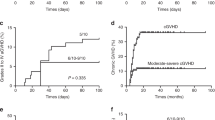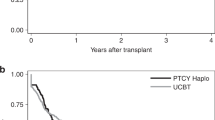Abstract
We report a single-center experience in treating 18 consecutive patients with severe aplastic anemia (SAA) who received unrelated cord blood transplantation (CBT). The median age was 17 years (range 5–61 years). Sixteen cases received a reduced-intensity regimen composed of CY (total dose1200 mg/m2), rabbit antithymocyte globulin (ATG, total dose 30 mg/kg) and fludarabine (FLU, total dose 120 mg/m2). CYA and mycophenolate mofetil were used as GVHD prophylaxis. Two patients were not evaluable for engraftment because of early death on day +21 and +22. Only one of the sixteen cases achieved engraftment, but experienced secondary graft failure 3 months post transplantation. Fifteen patients experienced primary graft rejection, but all of them acquired autologous recovery. The 3-month and 6-month cumulative incidence of response was 56% and 81%, respectively. So far, 16 patients have survived for 330–1913 days (median, 750 days) after transplantation. The probability of OS at 2 years was 88.9%. Our data indicate that CBT for newly diagnosed SAA using no irradiation but FLU and ATG-based conditioning still seems to inevitably lead to the high risk of rejection, but may facilitate autologous recovery and improve survival with low risk of transplant-related mortality.
This is a preview of subscription content, access via your institution
Access options
Subscribe to this journal
Receive 12 print issues and online access
$259.00 per year
only $21.58 per issue
Buy this article
- Purchase on Springer Link
- Instant access to full article PDF
Prices may be subject to local taxes which are calculated during checkout

Similar content being viewed by others
References
Montané E, Ibáñez L, Vidal X, Ballarin E, Puig R, Garc?a N et al. Epidemiology of aplastic anemia: a prospective multicenter study. Haematologica 2008; 93: 518–523.
Locasciulli A, Oneto R, Bacigalupo A, Socié G, Korthof E, Bekassy A et al. Outcome of patients with acquired aplastic anemia given first line bone marrow transplantation or immunosuppressive treatment in the last decade: a report from the European Group for Blood and Marrow Transplantation (EBMT). Haematologica 2007; 92: 11–18.
Gluckman E, Broxmeyer HA, Auerbach AD, Friedman HS, Douglas GW, Devergie A et al. Hematopoietic reconstitution in a patient with Fanconi's anemia by means of umbilical cord blood from an HLA-identical sibling. New Engl J Med 1989; 321: 1174–1178.
Prasad VK, Kurtzberg J . Umbilical cord blood transplantation for non-malignant diseases. Bone Marrow Transplant 2009; 44: 643–651.
Lau FY, Wong R, Chui CH, Cheng G . Successful engraftment in two adult patients with severe aplastic anemia using nonmyeloablative conditioning followed by unrelated HLA mismatched cord blood transplantation. J Hematother Stem Cell Res 2001; 10: 309–311.
Kusumi E, Miyakoshi S, Murashige N, Katayama Y, Kim SW, Yuji K et al. Successful reduced-intensity stem cell transplantation (RIST) with mismatched cord blood in a 70-yr-old patient with severe aplastic anemia (SAA). Bone Marrow Transplant 2003; 32: 1111–1112.
Mao P, Wang S, Wang S, Zhu Z, Liv Q, Xuv Y et al. Umbilical cord blood transplant for adult patients with severe aplastic anemia using antilymphocyte globulin and cyclophosphamide as conditioning therapy. Bone Marrow Transplant 2004; 33: 33–38.
Ohga S, Ichino K, Goto K, Hattori S, Nomura A, Takada H et al. Unrelated donor cord blood transplantation for childhood severe aplastic anemia after a modified conditioning. Pediatr Transplant 2006; 10: 497–500.
Bacigalupo A, Passweg J . Diagnosis and treatment of acquired aplastic anemia. Hematol Oncol Clin North Am 2009; 23: 159–170.
Srinivasan R, Takahashi Y, McCoy JP, Espinoza-Delgado I, Dorrance C, Igarashi T et al. Overcoming graft rejection in heavily transfused and allo-immunised patients with bone marrow failure syndromes using fludarabine-based haematopoietic cell transplantation. Br J Haematol 2006; 133: 305–314.
Resnick IB, Aker M, Shapira MY, Tsirigotis PD, Bitan M, Abdul-Hai A et al. Allogeneic stem cell transplantation for severe acquired aplastic anaemia using a fludarabine-based preparative regimen. Br J Haematol 2006; 133: 649–654.
George B, Mathews V, Viswabandya A, Kavitha ML, Srivastava A, Chandy M . Fludarabine and cyclophosphamide based reduced intensity conditioning (RIC) regimens reduce rejection and improve outcome in Indian patients undergoing allogeneic stem cell transplantation for severe aplastic anemia. Bone Marrow Transplant 2007; 40: 13–18.
Maury S, Bacigalupo A, Anderlini P, Aljurf M, Marsh J, Socié G et al. Improved outcome of patients older than 30 years receiving HLA-identical sibling hematopoietic stem cell transplantation for severe acquired aplastic anemia using fludarabine-based conditioning: a comparison with conventional conditioning regimen. Haematologica 2009; 94: 1312–1315.
Marsh JC, Ball SE, Darbyshire P, Gordon-Smith EC, Keidan AJ, Martin A et al. Guidelines for the diagnosis and management of acquired aplastic anaemia. Br J Haematol 2003; 123: 782–801.
Yoshimi A, Kojima S, Taniguchi S, Hara J, Matsui T, Takahashi Y et al. Unrelated cord blood transplantation for severe aplastic anemia. Biol Blood Marrow Transplant 2008; 14: 1057–1063.
Chan KW, McDonald L, Lim D, Grimley MS, Grayson G, Wall DA . Unrelated cord blood transplantation in children with idiopathic severe aplastic anemia. Bone Marrow Transplant 2008; 42: 589–595.
Young NS, Calado RT, Scheinberg P . Current concepts in the pathophysiology and treatment of aplastic anemia. Blood 2006; 108: 2509–2519.
Rocha V, Gluckman E, Eurocord-Netcord registry and European Blood and Marrow Transplant group. Improving outcomes of cord blood transplantation: HLA matching, cell dose and other graft- and transplantation-related factors. Br J Haematol 2009; 147: 262–274.
Ruggeri A, de Latour RP, Rocha V, Larghero J, Robin M, Rodrigues CA et al. Double cord blood transplantation in patients with high risk bone marrow failure syndromes. Br J Haematol 2008; 143: 404–408.
Lee JW, Kang HJ, Kim EK, Shin HY, Ahn HS . Successful salvage unrelated umbilical cord blood transplantation with two units after engraftment failure with single unit in severe aplastic anemia. J Korean Med Sci 2009; 24: 744–746.
Kang HJ, Lee JW, Kim H, Shin HY, Ahn HS . Successful first-line treatment with double umbilical cord blood transplantation in severe aplastic anemia. Bone Marrow Transplant 2010; 45: 955–956.
Yamamoto H, Kato D, Uchida N, Ishiwata K, Araoka H, Takagi S et al. Successful sustained engraftment after reduced-intensity umbilical cord blood transplantation for adult patients with severe aplastic anemia. Blood 2011; 117: 3240–3242.
Kojima S, Matsuyama T, Kato S, Kigasawa H, Kobayashi R, Kikuta A et al. Outcome of 154 patients with severe aplastic anemia who received transplants from unrelated donors: the Japan Marrow Donor Program. Blood 2002; 100: 799–803.
Deeg HJ, Amylon ID, Harris RE, Collins R, Beatty PG, Feig S et al. Marrow transplants from unrelated donors for patients with aplastic anemia: minimum effective dose of total body irradiation. Biol Blood Marrow Transplant 2001; 7: 208–215.
Takanashi M, Atsuta Y, Fujiwara K, Kodo H, Kai S, Sato H et al. The impact of anti-HLA antibodies on unrelated cord blood transplantations. Blood 2010; 116: 2839–2846.
Bacigalupo A, Bruno B, Saracco P, Di Bona E, Locasciulli A, Locatelli F, European Group for Blood and Marrow Transplantation (EBMT) Working Party on Severe Aplastic Anemia and the Gruppo Italino Trapianti di Midolio Osseo et al. Antilymphocyte globulin, cyclosporine, prednisolone, and granulocyte colony-stimulating factor for severe aplastic anemia: an update of the GITMO/EBMT study on 100 patients. Blood 2000; 95: 1931–1934.
Gutman JA, Turtle CJ, Manley TJ, Heimfeld S, Bernstein ID, Riddell SR et al. Single-unit dominance after double-unit umbilical cord blood transplantation coincides with a specific CD8+ T-cell response against the nonengrafted unit. Blood 2010; 115: 757–765.
Rosenfeld S, Follmann D, Nunez O, Young NS . Antithymocyte globulin and cyclosporine for severe aplastic anemia: association between hematologic response and long-term outcome. J Am Med Assoc 2003; 289: 1130–1135.
Acknowledgements
This research was supported by the International Cooperation Research Fund of Anhui Provincial Scientific and Technologic Committee (08080703026), the Fund of the Key Medical Project of Anhui Provincial healthy department (2010A005) and Anhui Provincial ‘115’ Industrial Innovation Program (2009).
Author information
Authors and Affiliations
Corresponding author
Ethics declarations
Competing interests
The authors declare no conflict of interest.
Rights and permissions
About this article
Cite this article
Liu, HL., Sun, ZM., Geng, LQ. et al. Unrelated cord blood transplantation for newly diagnosed patients with severe acquired aplastic anemia using a reduced-intensity conditioning: high graft rejection, but good survival. Bone Marrow Transplant 47, 1186–1190 (2012). https://doi.org/10.1038/bmt.2011.251
Received:
Revised:
Accepted:
Published:
Issue Date:
DOI: https://doi.org/10.1038/bmt.2011.251
Keywords
This article is cited by
-
Cord blood infusion-accelerated hematopoietic recovery after combined immunosuppressive therapy with fludarabine and rabbit ATG in severe aplastic anemia
International Journal of Hematology (2020)
-
Changes in the incidence, patterns and outcomes of graft failure following hematopoietic stem cell transplantation for Hurler syndrome
Bone Marrow Transplantation (2017)
-
Immunosuppressive therapy versus alternative donor hematopoietic stem cell transplantation for children with severe aplastic anemia who lack an HLA-matched familial donor
Bone Marrow Transplantation (2017)
-
Allogeneic hematopoietic cell transplantation for severe aplastic anemia: similar long-term overall survival after transplantation with related donors compared to unrelated donors
Bone Marrow Transplantation (2016)
-
Mesenchymal stromal cells to modulate immune reconstitution early post-hematopoietic cell transplantation
BMC Immunology (2015)



